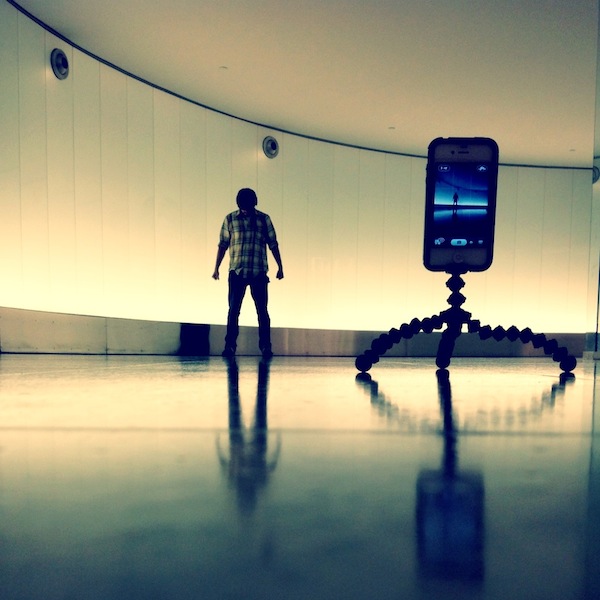
Exploring Instagram
Beyond Food Porn & Selfies
When Martin Reisch began working as a location scout, he never expected his place-holding, superhero-esque stance to become his trademark, let alone a verb recognized by his some 34 thousand followers on Instagram.
But, “Safesolventing,” which gets its name from Reisch’s handle @Safesolvent, has become what some savvy Instagrammers now recognize as the act of posing for a photo while standing defiantly, legs apart, hands down, and looking sort of epic.
Reisch, an often displaced Montrealer, initially used the pose in order to give scale to his landscape photos, especially when shooting from afar. He works as a professional freelance photographer and videographer, and fills his Instagram feed en route to and from work shoots, dedicating “probably more time than I’d like to admit” to meticulously editing and perfecting each photo he publishes.
Beyond being a free tool often used by smartphone owners to give the world a peek into their personal lives, Instagram has become a platform pivotal in shaping the careers and passions of many of its users. Since the app’s inception in 2010, it has flourished into a burgeoning social network, a meetup tool, a portfolio-sharing platform, an introduction to photography, and become the foundation of several emerging branding start-ups.
In Reisch’s case, his personal feed has become so successful that he can walk into Instagram’s headquarters and be recognized by his handle, and the distinctly styled photos attached to it. “My brand kind of just happened,” he said. “But it’s cool that I have a thing that people recognize as mine.” Having a distinct trademark is a characteristic that has proven common amongst those with mass-followings on Instagram.
Russian photographer Murad Osmann’s famed “follow me” feed even accidentally went viral. His Instagram feed, which has well over 400,000 followers, features a collection of images of his girlfriend Nataly guiding him around the world.
Osmann stumbled upon this now-famous format by fluke. He said he had a tendency to always spend too much time toying with his camera, and editing photos while travelling. This, he said, frustrated his girlfriend who was always eager to explore, and tended to pull him along. “Instagram initially was a tool to show my daily life, then it turned into a platform for my photography,” said Osmann.
“For a photographer to succeed on Instagram they have to be truly original — which is why street photographers are so popular there.”
But, while both Reisch and Osmann are photographers by profession, the app can be used by anyone with a smartphone. “Instagram is beneficial in increasing interest in the field of photography,” said Osmann. “It may be a start of many photography passions, I don’t think there is anything negative in having a large amount of amateur photographers out there.”
An October 2013 survey done by the Pew Research Institute study found that 18 per cent of smartphone users use Instagram, which was acquired by Facebook last year in a one billion dollar deal. Forbes has reported that the service now has over 150 million active users — that’s more than Twitter. At the end of this summer, the app had amassed 16 billion photos, receiving about a billion “likes” per day. These numbers make it the largest photo sharing service in existence.
Instagram announced in 2013 that it will, like many of its social-networking peers, begin rolling out ads into user’s feeds. In a blog post, Instagram stated that it would be starting off with just a few brands, and assured the public that its focus remains on creating a community that is both creative and connected. But, while the app is just now making an effort to further monetize itself, outside parties have already been hard at work finding alternative ways of profiting from the popularity of the photo-sharing network.
The Mobile Media Lab was born in March 2012, as a collaboration between three individually successful New York City Instagrammers, that met each other through the app. Collectively, the company’s three founders have nearly 850,000 followers. “We had been approached by similar brands and agencies to cover events or go to fashion shows,” said Brian DiFeo, one of MML’s co-founders. “We didn’t really know how to position ourselves as individuals but we did have a lot of opportunity, so we started the company to really shape the way brands work on Instagram.” Now, MML’s impressive client list includes the likes of Armani Exchange, VH1, Honda and Samsung.
The company works by selling marketing campaigns and branding strategies based within the Instagram network. “I think what we are doing is very unique,” said Difeo. “We have this network of well over 200 photographers all around the world, and they are everyday people that just really love Instagram, take great photos, and have built up their own audiences.” Those people, Difeo explained, are now getting paid to work with brands they probably never dreamed of, just for doing what they were doing anyways. “It’s just been really amazing to see and be a part of,” he said. While technology has a knack for changing quickly these days, Difeo is confident that Instagram is here to stay, at least for a while. “I think of all social networks, Instagram has the strongest community,” he said. “I think the longevity of the platform is certain because photography certainly is not going anywhere, and everyone is sort of becoming a photographer these days.”
Matt Jarry is a Montreal-based professional photographer, and an organizer of “Instagrammers Montreal”— a local organization that brings the community aspects of the app off of the internet, and onto the streets. The group hosts “instameets” for local photographers to gather, socialize, and share their personal shooting tricks of the trade.
It is one of many similar groups existing around the globe. “Everyone gets together, communicates, and talks. They comment on photos while chatting with the person who took them,” said Jarry. “Meetups are kind of a safe and fun place to be social, but at the same time you’ll definitely learn something.” Reisch thinks its hugely important to connect with people through the app. “Meeting people through Instagram is pretty rewarding,” he said. “Meeting someone just on the basis of a common interest in each others photography.”
When Martin Reisch began working as a location scout, he never expected his place-holding, superhero-esque stance to become his trademark, let alone a verb recognized by his some 34 thousand followers on Instagram.
But, “Safesolventing,” which gets its name from Reisch’s handle @Safesolvent, has become what some savvy Instagrammers now recognize as the act of posing for a photo while standing defiantly, legs apart, hands down, and looking sort of epic.
Reisch, an often displaced Montrealer, initially used the pose in order to give scale to his landscape photos, especially when shooting from afar. He works as a professional freelance photographer and videographer, and fills his Instagram feed en route to and from work shoots, dedicating “probably more time than I’d like to admit” to meticulously editing and perfecting each photo he publishes.
Beyond being a free tool often used by smartphone owners to give the world a peek into their personal lives, Instagram has become a platform pivotal in shaping the careers and passions of many of its users. Since the app’s inception in 2010, it has flourished into a burgeoning social network, a meetup tool, a portfolio-sharing platform, an introduction to photography, and become the foundation of several emerging branding start-ups.
In Reisch’s case, his personal feed has become so successful that he can walk into Instagram’s headquarters and be recognized by his handle, and the distinctly styled photos attached to it. “My brand kind of just happened,” he said. “But it’s cool that I have a thing that people recognize as mine.” Having a distinct trademark is a characteristic that has proven common amongst those with mass-followings on Instagram.
Russian photographer Murad Osmann’s famed “follow me” feed even accidentally went viral. His Instagram feed, which has well over 400,000 followers, features a collection of images of his girlfriend Nataly guiding him around the world.
Osmann stumbled upon this now-famous format by fluke. He said he had a tendency to always spend too much time toying with his camera, and editing photos while travelling. This, he said, frustrated his girlfriend who was always eager to explore, and tended to pull him along. “Instagram initially was a tool to show my daily life, then it turned into a platform for my photography,” said Osmann.
“For a photographer to succeed on Instagram they have to be truly original — which is why street photographers are so popular there.”
But, while both Reisch and Osmann are photographers by profession, the app can be used by anyone with a smartphone. “Instagram is beneficial in increasing interest in the field of photography,” said Osmann. “It may be a start of many photography passions, I don't think there is anything negative in having a large amount of amateur photographers out there.”
An October 2013 survey done by the Pew Research Institute study found that 18 per cent of smartphone users use Instagram, which was acquired by Facebook last year in a one billion dollar deal. Forbes has reported that the service now has over 150 million active users — that’s more than Twitter. At the end of this summer, the app had amassed 16 billion photos, receiving about a billion “likes” per day. These numbers make it the largest photo sharing service in existence.
Instagram announced in 2013 that it will, like many of its social-networking peers, begin rolling out ads into user’s feeds. In a blog post, Instagram stated that it would be starting off with just a few brands, and assured the public that its focus remains on creating a community that is both creative and connected. But, while the app is just now making an effort to further monetize itself, outside parties have already been hard at work finding alternative ways of profiting from the popularity of the photo-sharing network.
The Mobile Media Lab was born in March 2012, as a collaboration between three individually successful New York City Instagrammers, that met each other through the app. Collectively, the company’s three founders have nearly 850,000 followers. “We had been approached by similar brands and agencies to cover events or go to fashion shows,” said Brian DiFeo, one of MML’s co-founders. “We didn’t really know how to position ourselves as individuals but we did have a lot of opportunity, so we started the company to really shape the way brands work on Instagram.” Now, MML’s impressive client list includes the likes of Armani Exchange, VH1, Honda and Samsung.
The company works by selling marketing campaigns and branding strategies based within the Instagram network. “I think what we are doing is very unique,” said Difeo. “We have this network of well over 200 photographers all around the world, and they are everyday people that just really love Instagram, take great photos, and have built up their own audiences.” Those people, Difeo explained, are now getting paid to work with brands they probably never dreamed of, just for doing what they were doing anyways. “It’s just been really amazing to see and be a part of,” he said. While technology has a knack for changing quickly these days, Difeo is confident that Instagram is here to stay, at least for a while. “I think of all social networks, Instagram has the strongest community,” he said. “I think the longevity of the platform is certain because photography certainly is not going anywhere, and everyone is sort of becoming a photographer these days.”
Matt Jarry is a Montreal-based professional photographer, and an organizer of “Instagrammers Montreal”— a local organization that brings the community aspects of the app off of the internet, and onto the streets. The group hosts “instameets” for local photographers to gather, socialize, and share their personal shooting tricks of the trade.
It is one of many similar groups existing around the globe. “Everyone gets together, communicates, and talks. They comment on photos while chatting with the person who took them,” said Jarry. “Meetups are kind of a safe and fun place to be social, but at the same time you’ll definitely learn something.” Reisch thinks its hugely important to connect with people through the app. “Meeting people through Instagram is pretty rewarding,” he said. “Meeting someone just on the basis of a common interest in each others photography.”







